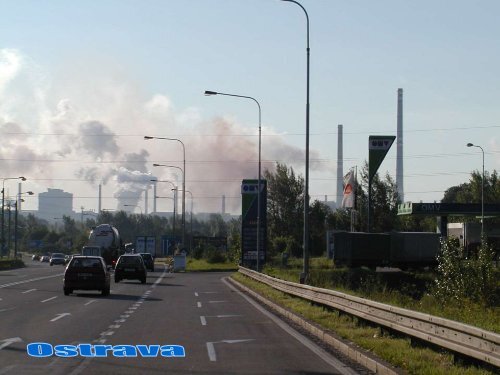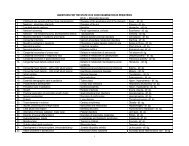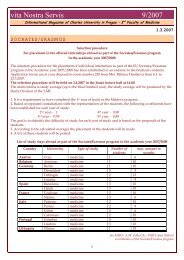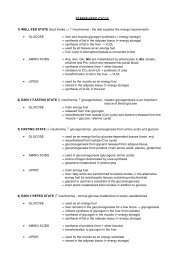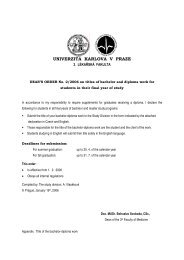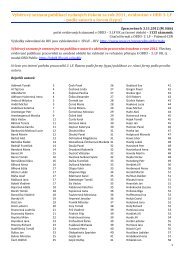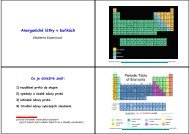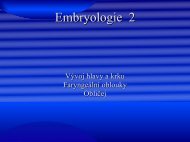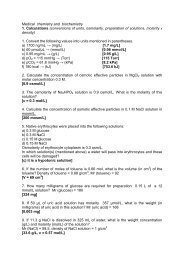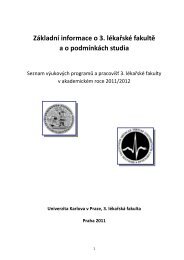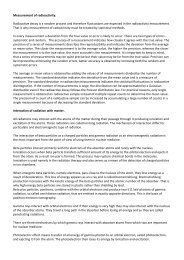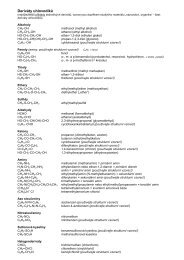Occupational exposure to chemicals. Toxic and genotoxic effects
Occupational exposure to chemicals. Toxic and genotoxic effects
Occupational exposure to chemicals. Toxic and genotoxic effects
You also want an ePaper? Increase the reach of your titles
YUMPU automatically turns print PDFs into web optimized ePapers that Google loves.
<strong>Occupational</strong><strong>exposure</strong> <strong>to</strong><strong>chemicals</strong>.<strong>Toxic</strong> <strong>and</strong> geno<strong>to</strong>xic <strong>effects</strong>Lead <strong>and</strong> mercury case studyJ. Volf2012
Prologue• Every year, 168,000 EU citizens diefrom work-related accidents ordiseases <strong>and</strong> 7 million are injured inaccidents, notes the resolution, whichwas drafted by Karima Delli (Greens/EFA,FR) <strong>and</strong> adopted with 371 votes in favour,47 against <strong>and</strong> 15 abstentions.(EUDecember 2011)Source:http://www.europarl.europa.eu/news/cs/pressroom/content/20111215IPR34231/html/Reinforcing-EU-legislation-on-health-<strong>and</strong>-safety-at-workJ. Volf 3
Contents• <strong>Occupational</strong> chemical hazardidentification/assessment– Elementary basis of the <strong>to</strong>xicology (repetition)• Exposure assessment in occupational/industrial<strong>to</strong>xicology• <strong>Occupational</strong> Healht Risk assessment• Prevention on occupational poisoning• Ethical aspects of the occupational risk analysis• Exercise – solvents, Case study II, Lead• Case study III MercuryJ. Volf 4
This Lesson Outcomes• Knowledge/information– <strong>Toxic</strong>ology repetition– About occupational safetyprogram UN– The basicsoccupational/industrial<strong>to</strong>xicology– About occupational<strong>exposure</strong> st<strong>and</strong>ards <strong>and</strong>measurements– About representativechemical substances• Skills– Recognize thecharacteristic smell ofsome industrial solvents– Use several informationsources of MAC• Attitudes– Ethical aspectsoccupational <strong>exposure</strong> <strong>to</strong><strong>chemicals</strong> as a part ofoccupational medicine.– Ethical aspects ofepidemiological study inoccupational medicineJ. Volf 5
Why we are talking about occupational<strong>exposure</strong> <strong>to</strong> <strong>chemicals</strong>?• MD‘s role for patients/clients– Have <strong>to</strong> be able recognize the etiology ofdiseases – occupational risk– Participated on prevention• The MD‘s role in consultation for employ,employer, trade unions– Use nature authority for health benefits,wellbeingJ. Volf 6
MD <strong>and</strong> occupational <strong>exposure</strong> <strong>to</strong><strong>chemicals</strong>• GP – symp<strong>to</strong>ms, syndromes of suspectpoisoning /in<strong>to</strong>xications– Rare but exists– <strong>Occupational</strong> anamnesis– Preventive examination of employ• Specialist– Communication with all field of medicine– Special diagnosis <strong>and</strong> treatment ofprofessional poisoningJ. Volf 7
The repetition of <strong>to</strong>xicologyJ. Volf 8
His<strong>to</strong>ry• Phillip von Hohenheim (1493–1541) was analchemist, physician, astrologer etc.• ‗father of <strong>to</strong>xicology‘. Of course,most of usknowhim as ―Paracelsus‖,• A title that he <strong>to</strong>ok late in his life that means, ―equal <strong>to</strong> or greaterthan Celsus‖, who was a Roman from the first century known for histract on medicine• “All things are poison <strong>and</strong> nothing iswithout poison, only the dose permitssomething not <strong>to</strong> be poisonous.”J. Volf 9
What is a <strong>to</strong>xin?τοξικόν <strong>to</strong>xikonThis term refers <strong>to</strong> <strong>to</strong>xic substances that areproduced naturally (nature origin)J. Volf 10
What is a <strong>to</strong>xicants?This term refers <strong>to</strong> <strong>to</strong>xic substances thatare produced by or are a by-product ofhuman made activitiesJ. Volf 12
What is <strong>to</strong>xicology?1stThe study of the nature, <strong>effects</strong>, <strong>and</strong>detection of poisons <strong>and</strong> the treatment ofpoisoning.J. Volf 13
What is <strong>to</strong>xicology?2nd<strong>Toxic</strong>ology is a branch of medicine, biology,chemistry <strong>and</strong> some others (e.g.pharmacology, genetic, law) concerned withthe study of the adverse <strong>effects</strong> of <strong>chemicals</strong>on living organisms. It is the study ofsymp<strong>to</strong>ms, mechanisms, treatments <strong>and</strong>detection of poisoning, especially thepoisoning of people.See more: http://en.wikipedia.org/wiki/<strong>Toxic</strong>ologyJ. Volf 14
<strong>Toxic</strong>o kinetics(pharmacokinetics)– what the body does with the substance (absorption,distribution, biotransformation, excretion)Clearance – measure of the body´s ability <strong>to</strong> eliminate asubstanceBioavailability – the rate <strong>and</strong> extent <strong>to</strong> which asubstance becomes available <strong>to</strong> target placeAge- or gender- related dependency of kineticsJ. Volf15
<strong>Toxic</strong>odynamics(pharmacodynamics)-what the substance does <strong>to</strong> the body(<strong>effects</strong> <strong>and</strong> mechanisms of actions):S<strong>to</strong>chastic or non-s<strong>to</strong>chastic effect(threshold)Organ-specific <strong>to</strong>xic effectAcute – sub-chronic – chronic effectDelayed effect: mutagenic, carcinogenic,tera<strong>to</strong>genic, allergenicJ. Volf16
The <strong>to</strong>xicological paradigmJ. Volf17
Xenobiotic metabolism•Phase I: oxidation, reduction,hydrolysis•Phase II: conjugation•Biotransformation via intestinalmicro-flora: reduction, deconjugationJ. Volf18
Fac<strong>to</strong>rs influencing xenobiotic metabolismSusceptibility fac<strong>to</strong>rsInduction of expression of the enzyme protein(upregulation)Repression of the expression of the enzymeprotein (downregulation)Direct activation of the enzymatic functionDirect inhibition of the enzymatic functionJ. Volf19
Free radicals•Chemical entities with one or more unpairedelectrons.•Biological <strong>effects</strong>:•Reaction with virtually all molecules in living cells•Cy<strong>to</strong><strong>to</strong>xic <strong>and</strong> geno<strong>to</strong>xic <strong>effects</strong>•Damage of cellular membranes,•Interaction with proteins,•Interaction with lipids (lipid per oxidation)•The degree of damage will depend on the balancebetween radical formation <strong>and</strong> radical inactivationJ. Volf20
Genomics• Gene sequencing, which applies various biochemical• <strong>and</strong> bioinformatics <strong>to</strong>ols <strong>to</strong> study the DNA of organisms.• Genotype analysis that looks at genetic variation betweenindividuals <strong>and</strong> in populations.• Epigenetics that studies reversible changes in gene functionthat can be passed from parent <strong>to</strong> child.• Transcrip<strong>to</strong>mics (or gene expression profiling) is the studyof mRNA—the intermediary step between genes <strong>and</strong> proteinsthat indicates genes that are active (as opposed <strong>to</strong> dormant orsilent).• Proteomics is the study of proteomes, which are collectionsof proteins. Proteins carry out the functions encoded bygenes.• Metabolomics is the study of the products of biologicalprocesses. Such products change in response <strong>to</strong> such thingsas nutrition, stress, <strong>and</strong> disease states.J. Volf21
Processes in the <strong>to</strong>xicologycancerogenic substancesJ. Volf 22
Chemical carcinogensTypeGeno<strong>to</strong>xic: DirectIndirectInorganic carcinogensExampleAlkylating agentsPAHs, Aromatic amines,nitroarenes, myco<strong>to</strong>xinsNi, Cr, Cd, AsEpigenetic (nongeno<strong>to</strong>xic):Cy<strong>to</strong><strong>to</strong>xicSolid bodies, fibresTumor promo<strong>to</strong>rsHormonesImmunosuppressantMi<strong>to</strong>gens, proliferating agensAsbes<strong>to</strong>sTCDD, DDTEstradiol, DESAzathioprine, cyclosporin APeroxisome prolifera<strong>to</strong>rs J. Volf Phthalates, clofibrate 23
The control questions I?• What is a difference between <strong>to</strong>xic <strong>and</strong><strong>to</strong>xicant?• What is a <strong>to</strong>xicodynamic?• What is a <strong>to</strong>xicokinetic?• What is initiating faze in cancerdevelopment?
<strong>Occupational</strong>/industrial<strong>to</strong>xicology/hygieneJ. Volf 25
What is occupational<strong>to</strong>xicology?• <strong>Occupational</strong> /industrial <strong>to</strong>xicologyincludes the <strong>effects</strong> ofindustrial/occupational <strong>to</strong>xicants onhealth of employ.• Theory:„Exposure healthy employee <strong>to</strong>known concentration of the knownsubstances„• The field combines both regulation,research, <strong>and</strong> risk assessment.J. Volf 26
The algorithm of an industrialhygiene• Health hazard recognition.• Health hazard evaluation.• Health hazard control.• Employee education <strong>and</strong> training.• Audit of the program‘s effectiveness <strong>and</strong>update of the program for continuousimprovement.Source <strong>and</strong> more:http://www.aist.org/safetyfirst/Safety_Mar09.pdfJ. Volf 27
Risk Assessmentin occupational medicine• St<strong>and</strong>ard <strong>and</strong> transparent process haw <strong>to</strong>move from data <strong>to</strong> information• Legal duty for employer• A <strong>to</strong>ol of the occupational diseases, <strong>and</strong>poisons preventionJ. Volf 28
The risk-based industrialhygiene assessment• Type of hazard (chemical, physical, <strong>and</strong>biological)• <strong>Toxic</strong>ity• Quantity in use• Duration of use• Past moni<strong>to</strong>ring data• Established occupational <strong>exposure</strong> models• Source <strong>and</strong> more: http://wwwgroup.slac.stanford.edu/esh/eshmanual/references/IHGuideSurvey.pdfJ. Volf 29
How <strong>to</strong> assess the risks in yourworkplace?1 Identify the hazards2 Decide who might be harmed <strong>and</strong> how3 Evaluate the risks <strong>and</strong> decide onprecautions4 Record your findings <strong>and</strong> implement them5 Review your assessment <strong>and</strong> update ifnecessaryJ. Volf 30
<strong>Occupational</strong> <strong>exposure</strong>J. Volf 31
<strong>Occupational</strong> <strong>exposure</strong>• The <strong>exposure</strong> <strong>to</strong> potentially harmfulchemical, physical, or biological agents tha<strong>to</strong>ccurs as a result of one's occupation.– Medical aspects– Legal aspectsSource: http://www.reference.md/files/D016/mD016273.htmlJ. Volf 32
<strong>Occupational</strong> <strong>exposure</strong>• Not only doses makes difference between„<strong>to</strong>xicologies―.(mg.m -3 vs µg. m -3 )• Differences exist in <strong>exposure</strong> scenario(8hours vs.24 hours, only in the adulthood)• Exposure assessment (limits TLVs,OEL,MAC) Can be individualygague.Personal protecting equipment.• Optionality ? (USA principles?)J. Volf 33
<strong>Occupational</strong> <strong>exposure</strong> routes• Inhalation– Dust (partly p.o. <strong>exposure</strong>)• Particles• Fibres– Aerosols (mist, fog)– Vapours– Gaseous• Cutaneos /skin absorptionJ. Volf 34
The particles fractions as defined inEN481 (1993)• inhalable fraction (the mass fraction of particles which canbe inhaled by nose or mouth); since there are no experimental dataon inhalable fraction of particles with an aerodynamic diameter of >100 μm, particles > 100 μm are not included in the inhalableconvention,• thoracic fraction (the mass fraction of particles that passesthe larynx); the median value of the particle size is 11.64 μm with ageometric st<strong>and</strong>ard deviation (GSD) of 1.5 μm. It has been shownthat 50 % of the particles in air with an aerodynamic diameter of 10μm belong <strong>to</strong> the thoracic fraction,• respirable fraction (the mass fraction of particles thatreaches the alveoli); the median value is 4.25 μm with a GSD of 1.5μm. It has been shown that 50 % of the particles with anaerodynamic diameter of 4 μm belong <strong>to</strong> the respirable fraction.J. Volf 35
Exposure charactersJ. Volf 36Source:Thomas Kensler, PhD , Bloomberg School of Public Health
Maximum AllowableConcentration (MAC)• The maximum <strong>exposure</strong> <strong>to</strong> a biologicallyactive physical or chemical agent that isallowed during an 8-hour period (aworkday) in a population of workers, orduring a 24-hour period in the generalpopulation, which does not appear <strong>to</strong>cause appreciable harm, whetherimmediate or delayed for any period, in thetarget population. (From Lewis Dictionaryof <strong>Toxic</strong>ology, 1st ed) J. Volf 37
The threshold limit value(TLV)• is a level <strong>to</strong> which it is believed a worker can be exposedday after day for a working lifetime without adversehealth <strong>effects</strong>. Strictly speaking, TLV is a reserved termof the American Conference of GovernmentalIndustrial Hygienists (ACGIH).• TLVs, along with biological <strong>exposure</strong> indices (BEIs), arepublished annually by the ACGIH.• See http://www.acgih.org/home.htmJ. Volf 38
TLV („gold― st<strong>and</strong>ard)• Time weighted average (TLV-TWA): average<strong>exposure</strong> on the basis of a 8h/day, 40h/weekwork schedule• Short-term <strong>exposure</strong> limit (TLV-STEL): spot<strong>exposure</strong> for a duration of 15 minutes, thatcannot be repeated more than 4 times per day• Ceiling limit (TLV-C): absolute <strong>exposure</strong> limitthat should not be exceeded at any timeJ. Volf 39
Guidance for Interpreting theCarcinogenicity Notation (US)Carcinogenicity• Goal <strong>to</strong> synthesize information <strong>to</strong> be useful <strong>to</strong>practicing industrial hygienist• 5 category system that evolves <strong>to</strong> reflectadvances in science• Exposures <strong>to</strong> carcinogens should be kept <strong>to</strong> aminimum – For A1 agents with a TLV ® <strong>and</strong> forA2 <strong>and</strong> A3 agents <strong>exposure</strong> by all routes shouldbe controlled• For agents with no designation – no human oranimal data available <strong>to</strong> assign
The example of regulation• DIRECTIVE 2008/112/EC OF THE EUROPEANPARLIAMENT AND OF THE COUNCIL of 16December 2008 amending Council Directives76/768/EEC, 88/378/EEC, 1999/13/EC <strong>and</strong> Directives2000/53/EC, 2002/96/EC <strong>and</strong> 2004/42/EC of theEuropean Parliament <strong>and</strong> of the Council in order <strong>to</strong>adapt them <strong>to</strong> Regulation (EC) No 1272/2008 onclassification, labelling <strong>and</strong> packaging of substances<strong>and</strong> mixturesJ. Volf 41
<strong>Occupational</strong> <strong>exposure</strong>assessmentJ. Volf 42
The <strong>exposure</strong> measurementstrategy I• Qualitative (What)– technology assessment <strong>and</strong>– literature review– Qualitative analysis of occupationalenvironment• Quantitative (How much, many)– Assessment of the potential employee<strong>exposure</strong>s– Observance of OEL, MACs, TLVs, PELJ. Volf 43
J. Volf 44
J. Volf 45
J. Volf 46
J. Volf 47NIOSH http://www.cdc.gov/niosh/docs/77-173/pdfs/77-173.pdf
The <strong>exposure</strong> tactics• Air concentration– Personal air sampling• Active• Passive– Area air sampling (active, passive)– Wipe sampling– Biological <strong>exposure</strong> test (urine, blood, alveolar air• Direct• IndirectJ. Volf 48
J. Volf 49
Personal samplingJ. Volf 50http://www.foi.se/upload/projects/EIHH/presentations/hakan-wingfors.pdf
Working area/stationarymeasurements• Results can be used for <strong>exposure</strong> limitscomparison only with time activitiespatterns record (TLW, PEL) usually 8 hourshifts• Simple• Cheaper• Les representative for individual <strong>exposure</strong>• Norm regulate the statistics or resultsJ. Volf 51
Biological moni<strong>to</strong>ring/analyses• Biological <strong>exposure</strong> indices (BEI)• Biological <strong>exposure</strong> tests CZE (BET)• Cy<strong>to</strong>genetic analysis:– Biomarker of <strong>exposure</strong> <strong>to</strong> gene-<strong>to</strong>xiccarcinogens– Biomarker of early adverse effect (reversible)J. Volf 52
The BEI ® – Definition• Biological moni<strong>to</strong>ring … entailsmeasurement of the concentration of achemical determinant in the biologicalmedia of the exposed <strong>and</strong> is an indica<strong>to</strong>rof the uptake of the substance.• The BEI ® determinant can be thechemical itself; one or more metabolites;or a characteristic reversible biochemicalchange induced by the chemical.http://www.google.cz/url?sa=t&rct=j&q=biomeoni<strong>to</strong>ring%20tlv&source=web&cd=1&ved=0CCQQFjAA&url=http%3A%2F%2Fwww.acgih.org%2Ftlv%2FTLV03Pres_BEI.ppt&ei=OM5DT-P_POih4gTnqsW1CA&usg=AFQjCNFlLn5Ocz1mGDZDC188B4XF80Lwxw
Guidance for Interpretingthe BEI ® Notation• Refers <strong>to</strong> existence of a Biological ExposureIndex (BEI ® ) for the agent• Biomoni<strong>to</strong>ring serves as a complement <strong>to</strong><strong>exposure</strong> assessment by air sampling• Most BEIs ® based on direct correlation <strong>to</strong> TLV ®(conc. of determinant at TLV ® <strong>exposure</strong>)• BEIs ® used as guidelines in evaluation ofpotential hazards
BET IJ. Volf 55
BET IIJ. Volf 56
Chromosomal aberrations <strong>and</strong> cancer riskThree epidemiologic studies:Nordic countries – Italy – Czech Republicfound a significant association between the numberof chromosomal aberrations in population <strong>and</strong> therisk of cancerElimination or reduction of occupational <strong>exposure</strong> istherefore very important <strong>to</strong> preven<strong>to</strong>ccupationally-related neoplasmsSource: Prof. Černá presentation 2012
Control questions II?1. What inform MD result from biological<strong>exposure</strong> indica<strong>to</strong>rs/tests?2. What are differences between work area<strong>and</strong> personal sampling?3. Why <strong>and</strong> when we use cy<strong>to</strong>geneticanalyses?4. Do you know any tests used ingono<strong>to</strong>xicology?
Ethical aspects in theoccupational/industrial <strong>to</strong>xicologyJ. Volf 68
Specific occupational medicine„schism― <strong>to</strong> serve• Employer– Be protected againsthealth problems• occupational diseasesoccurrence– Give information• about technology• hazard substance,• concentrations in theoccupationalenvironment• etc• Employee– Is a client (or patient)– Has a right beprotected– Has a right <strong>to</strong> know– Has a right <strong>to</strong> work– Has a duty <strong>to</strong> giveinformation, samplesparticipate preventive<strong>and</strong> periodical medicalexaminationJ. Volf 69
<strong>Occupational</strong> medical doc<strong>to</strong>r• Have <strong>to</strong> protect c<strong>and</strong>idates or workersagain discrimination, social <strong>and</strong> health risk• Prevent the poisoning, occupationaldisease• Have <strong>to</strong> be „fair― <strong>to</strong> employer• In any case protect medical secret –health status <strong>and</strong> susceptibility of worker• Decide …..APTUS(A)J. Volf 70
Ars medici/evidence basedmedicinehttp://www.rozmani<strong>to</strong>sti.eu/zboziJ. Volf 71
Preventive measurments inindustrial/occupational<strong>to</strong>xicologyJ. Volf 72
Preventive measurements• Legal <strong>to</strong>ols (convention, acts, agreements)– Some hazards substances are prohibit– Some work (job) are prohibit for women• Technology– Without hazard substances– Sealing (close technology)– Ventilation• Organisation– Brakes– PPE• PromotionJ. Volf 73
World• UN• ILO International LaborOrganization/Office (1919/1946)http://www.ilo.org/global/lang--en/index.htm#a3• WHOJ. Volf 74
Introduce• International Programme on ChemicalSafety• IPCS WHOJ. Volf 75Source:WHO Geneva
USA• American Conference of GovernomentalIndustrial Hygienists (1938 /1946)• http://www.acgih.org/home.htm• Thershold Limit Values (1941)• OSHAJ. Volf 76
EU <strong>Occupational</strong> health agencyOSHA EUhttp://osha.europa.eu/enJ. Volf 77
REACHREACH is the European CommunityRegulation on <strong>chemicals</strong> <strong>and</strong> their safeuse (EC 1907/2006). It deals with theRegistration, Evaluation, Authorisation <strong>and</strong>Restriction of Chemical substances. Thelaw entered in<strong>to</strong> force on 1 June 2007.More: http://ec.europa.eu/environment/<strong>chemicals</strong>/reach/reach_intro.htmJ. Volf 78
Carcinogens <strong>and</strong> Mutagens at workEU• DIRECTIVE 2004/37/EC OF THE EUROPEANPARLIAMENT AND OF THE COUNCILof 29April 2004 on the protection of workers fromthe risks related <strong>to</strong> <strong>exposure</strong> <strong>to</strong> carcinogensor mutagens at work (Sixth individualDirective within the meaning of Article 16(1)of Council Directive 89/391/EEC) (codifiedversion)• http://eurlex.europa.eu/LexUriServ/LexUriServ.do?uri=OJ:L:2004:229:0023:0034:EN:PDFJ. Volf 79
EU statistics• COMMISSION REGULATION (EU) No349/2011 of 11 April 2011 implementingRegulation (EC) No 1338/2008 of theEuropean Parliament <strong>and</strong> of theCouncil on Community statistics onpublic health <strong>and</strong> health <strong>and</strong> safety atwork, as regards statistics on accidentsat workJ. Volf 80
EU Directives OSH• Exposure <strong>to</strong> chemical agents <strong>and</strong> chemical safety - OSH directives• Directive 2009/161/EU - indicative occupational <strong>exposure</strong> limit values– of 17 December 2009 establishing a third list of indicative occupational <strong>exposure</strong> limit values inimplementation of Council Directive 98/24/EC <strong>and</strong> amending Commission Directive 2000/39/EC (Text withEEA relevance)• Directive 2009/148/EC - <strong>exposure</strong> <strong>to</strong> asbes<strong>to</strong>s at work– of 30 November 2009 on the protection of workers from the risks related <strong>to</strong> <strong>exposure</strong> <strong>to</strong> asbes<strong>to</strong>s at work(Text with EEA relevance)• Directive 2006/15/EC - indicative occupational <strong>exposure</strong> limit values– of 7 February 2006 establishing a second list of indicative occupational <strong>exposure</strong> limit values inimplementation of Council Directive 98/24/EC <strong>and</strong> amending Directives 91/322/EEC <strong>and</strong> 2000/39/EC• Directive 2004/37/EC - carcinogens or mutagens at work– of 29 April 2004 on the protection of workers from the risks related <strong>to</strong> <strong>exposure</strong> <strong>to</strong> carcinogens or mutagensat work (Sixth individual Directive within the meaning of Article 16(1) Directive 89/391/EEC)• Directive 2000/39/EC - indicative occupational <strong>exposure</strong> limit values– of 8 June 2000 establishing a first list of indicative occupational <strong>exposure</strong> limit values in implementation ofCouncil Directive 98/24/EC on the protection of the health <strong>and</strong> safety of workers from the risks related <strong>to</strong>chemical agents at work.• Directive 98/24/EC - risks related <strong>to</strong> chemical agents at work– of 7 April 1998 on the protection of the health <strong>and</strong> safety of workers from the risks related <strong>to</strong> chemical agentsat work (fourteenth individual Directive within the meaning of Article 16(1) of Directive 89/391/EEC)• Directive 91/322/EEC - indicative limit values– of 29 May 1991 on establishing indicative limit values by implementing Council Directive 80/1107/EEC onthe protection of workers from the risks related <strong>to</strong> <strong>exposure</strong> <strong>to</strong> chemical, physical <strong>and</strong> biological agents atwork.J. Volf 81
Information sources• Books• Journals• D bases• Poison (<strong>Toxic</strong>ological)Control Centres• <strong>Toxic</strong>ological information centres <strong>and</strong>Phone lines (call centres)J. Volf 82
Information data sources• http://epp.eurostat.ec.europa.eu/portal/page/portal/health/health_safety_workJ. Volf 83
<strong>Toxic</strong>ological Databases (free)II• http://ull.chemistry.uakron.edu/erd/index.html• http://www.atsdr.cdc.gov/<strong>to</strong>xpro2.html• http://potency.berkeley.edu/cpdb.html• http://www.epa.gov/eco<strong>to</strong>x• http://ace.ace.orst.edu/info/ex<strong>to</strong>xnet• http://www.epa.gov/gap-db/gapdb.htm• http://<strong>to</strong>xnet.nlm.nih.gov/• http://www.state.nj.us/health/eoh/rtkweb/rtkhsfs.htm• http://193.51.164.11/cgi/ihound/chem/ih_chem_frames.html• http://www.cdc.gov/niosh/ipcs/icstart.htmlJ. Volf 84
<strong>Toxic</strong>ological Databases (free)II• http://www.inchem.org• http://www.epa.gov/iris/index.html• http://www.cdc.gov/niosh/idlh/idlh-1.html• http://www.cdc.gov/niosh/npg/pgdstart.html• http://www.osha-slc.gov/sltc/healthguidelines/index.html• http://ntp.niehs.nih.gov/• http://www.cdc.gov/niosh/pel88/npelname.html• http://solvdb.ncms.org/index.html• http://www.uvp5.univ-paris5.fr/tele<strong>to</strong>x/• http://www.egora.fr/html/rechercher_htm/<strong>to</strong>xin_gp.htmJ. Volf 85
Poison centres• Czech poison centre Phone: 224 91 92 93http://www.tis-cz.cz/http://www.who.int/gho/phe/chemical_safety/phe_poison_centres_20110701.xlsJ. Volf 86
http://www.aapcc.org/dnn/default.aspxJ. Volf 87
Source of an additional information• http://www.ilocis.org/en/default.html• http://www.hse.gov.uk/risk/fivesteps.htm• http://www.atsdr.cdc.gov/training/<strong>to</strong>xmanual/pdf/module-1.pdfJ. Volf 88
International Labor Organization (ILO)Chemical Control• <strong>Occupational</strong> <strong>exposure</strong> <strong>to</strong> <strong>chemicals</strong> <strong>to</strong>xic <strong>and</strong>geno<strong>to</strong>xic Toolkit see:http://www.ilo.org/legacy/english/protection/safework/ctrl_b<strong>and</strong>ing/<strong>to</strong>olkit/icct/index.htmJ. Volf 89
J. Volf 90
Control questions III?1. Do you know effective preventivemeasure on occupational <strong>to</strong>xicology?2. Do you know the name of international<strong>and</strong> important national agencies foroccupational medicine/industrial hygieneor occupational health <strong>and</strong> safety?3. What do you know about poisonscentre?
ExercisesJ. Volf 92
Olfac<strong>to</strong>ry sens• Is very important <strong>to</strong>ol in any medicine• It is more important in industrial <strong>to</strong>xicology• Olfac<strong>to</strong>metrie is common use methodologyTask use the nose for recognise thecemical substance – solvent– CAVE! Protect your olfacory sens with „goodsmell practice―
The solution?Will be given after the exerciseJ. Volf 94
Exercise• There is a set of samples– A– B– C– D– EJ. Volf 95
Case studiesJ. Volf 96
Important occupational hazardouschemical substances– Lead– Mercury– Cadmium– Industrial solventsJ. Volf 97
Lead• http://www.ila-lead.org/leadinformation/lead-the-facts• http://www.ncbi.nlm.nih.gov/pmc/articles/PMC1874356/pdf/bcp0053-0451.pdfJ. Volf 98
Lead<strong>Occupational</strong> <strong>exposure</strong>: battery manufacturing, lead smeltersAcute <strong>to</strong>xicity of inorganic lead:Intestinal colics, nausea, constipation, diarrhea, abdominal pain, capillaryspasm, irritation, encephalopathy, ataxiaChronic <strong>to</strong>xicity of inorganic lead:Affect hema<strong>to</strong>poetic system (micro-or normocyte anemia based on theinteraction with hemoglobin synthesis in bone marrow). GIT (abdominalpain, constipation, diarrhea),Organic lead: Central <strong>and</strong> peripheral nervous system (loss ofconcentration, impaired memory, in children negative impact onintelligence)Source: Prof. Černá presentation 2012
Lead (cont.)Kidney (nephropathy)Cardiovascular effect (?)Reproduction, carcinogenicityThe big age dependent <strong>to</strong>xic <strong>effects</strong>!!!!CAVE! Small children. (parents clothes)Plumbemia BLL 10 μg/dLTherapy: BAL, EDTAMore: http://www.websters-dictionary-online.com
Source: Prof. Černá presentation 2012Correlation between blood lead level<strong>and</strong> <strong>effects</strong>B-Pb mg/lEffect>150 Inhibition of -aminolevulinic aciddehydratase100-200 Impaired intellectual <strong>and</strong> cognitivedevelopment of children200-600 Increased erythrocyte pro<strong>to</strong>porphyrin conc.>400 Increased urinary coproporphyrin <strong>and</strong> -ALAconcentration500-600 Chronic encephalopathy in children>800 Chronic encephalopathy in adults600-800 Peripheral neuropathy700-1000 Impaired renal function800-3000 Acute lead encephalopathy
Mercury• http://www.biomedcentral.com/content/pdf/1471-227X-10-7.pdfJ. Volf 102
Elemental mercury vapour.MercuryAcute <strong>to</strong>xicity: inhalation - rare, pneumonia, emphysema,orally – GIT problemsChronic: akrodynia, nephrotic syndrome, gingivitis, tremormercurialise, erethism, polyneuropathyMercury salts:Acute: Orally erosive effect, hemorrhagic vomiting, renaldamageChronic (see vapour)Methyl mercury:Acute: CNS effect; paresthesia, ataxia, loss of sensation,difficulties with speaking <strong>and</strong> hearing.Chronic: similar <strong>to</strong> acuteTera<strong>to</strong>genic, mutagenic, carcinogenic <strong>effects</strong>
Cadmium•Very long biological half-life (10 – 30 y)•<strong>Occupational</strong> <strong>exposure</strong> <strong>to</strong> Cd dust or aerosols•Inhalation <strong>exposure</strong> – 40 <strong>to</strong> 50 % of inhaled Cd isabsorbed•Absorption from GIT is about 2 – 8 % (higher resorption inwomen)•Albumin-bound Cd – liver - metalothionein•Cd does not cross substantially the placenta barrier•Renal cortex is the target organSource: Prof. Černá presentation 2012
Cadmium – adverse health <strong>effects</strong>Carcinogen for human (Class 1 according <strong>to</strong> IARC)Kidney dysfunction (proteinuria, increased excretion ofalbumins, globulins, 2 -microglobulinsOsteoporosis, interference with calcium metabolismItai-Itai disease (osteomalacia)Hypertension??Source: Prof. Černá presentation 2012
Aromatic hydrocarbonsBenzene, <strong>to</strong>luene, xyleneBenzene:According <strong>to</strong> ILO convention in 1972, the use of benzeneis prohibited if suitable substitute products are availableInhalation is dominant route of human <strong>exposure</strong><strong>Occupational</strong> <strong>exposure</strong>: petrochemical industry, petrolstationEnvironmental <strong>exposure</strong>: ambient air, indoor air, smokingSource: Prof. Černá presentation 2012
Benzene – kinetics <strong>and</strong> health <strong>effects</strong>• Inhalation <strong>and</strong> dermal absorption,• Because of lipophilic character the highest level isin organs with the high lipid amount• Acute <strong>to</strong>xicity:•Mild form - dizziness, excitation, euphoria,headache, nausea, vomiting•Severe form – visual disturbance, shallow<strong>and</strong> rapid pulse, breathlessness, profoundCNS depression, loss of consciousness,collapseSource: Prof. Černá presentation 2012
Benzene – chronic <strong>and</strong> delayed <strong>effects</strong>•Hema<strong>to</strong>poetic disorders:•Erythropoetic system: aplastic anemia, erythroblastic myelosis, acuteerythremia•Leukopoetic system: leukopenia, leukemia, lymphocy<strong>to</strong>sis•Thrombopoetic system: thrombocy<strong>to</strong>penia•Carcinogenicity (leukemia)•Immuno<strong>to</strong>xicitySource: Prof. Černá presentation 2012
TolueneEmissions of mo<strong>to</strong>r vehicles, mineral- oil industry,industrial use as solvent etc.Inhalation, dermal absorptionAcute <strong>and</strong> chronic <strong>to</strong>xicity:Euphoria, irritation, narcotic effectPseudoneurasthenic syndrome (mental lability, sleepdisturbance, chronic fatiguePsychoorganic syndrome (changes in mental performance, lossof personality)Reproductive <strong>to</strong>xicitySource: Prof. Černá presentation 2012
Halogenated hydrocarbonsUse:Lipophilic compounds, mostly used as solvents:dichloromethane, trichloroethylene, trichloroethane(chloroform), tetrachloroethylene (perchlorethylene).Vinyl chloride = monomeric constituent for PVCKinetics: inhalation absorption, extensivebiotransformationSource: Prof. Černá presentation 2012
Halogenated hydrocarbonsAdverse health <strong>effects</strong>:Irritation, anesthetic effect, depressive <strong>effects</strong> on CNSDamage <strong>to</strong> parenchymal organs (liver, kidney)Mutagenicity, potential carcinogenicityReproductive <strong>and</strong> developmental <strong>to</strong>xicitySource: Prof. Černá presentation 2012
Organophosphate insecticidesLarge <strong>and</strong> well-defined class of pesticidesThe <strong>to</strong>xicity is the result of excessive stimulationof cholinergic nerves based on the ability <strong>to</strong> inhibitacetylcholinesterase.Rapid hydrolysation of acetylcholin at thepostganglionic membrane of the synapse.Organophosphates bind more tightly <strong>to</strong> theenzymes active site that does acetylcholine.Accumulation of acetylcholine at the recep<strong>to</strong>rSource: Prof. Černá presentation 2012
Organophosphate insecticidesSymp<strong>to</strong>ms of <strong>to</strong>xicity result from cholinesterase inhibition:Headache, giddiness, nervousness, blurred vision,weakness, nausea, cramps, diarrhea.Sweating, miosis, vomiting, cyanosis, convulsions, coma,cardiac arrhythmia, respira<strong>to</strong>ry failure.Delayed neuropathyTherapy: atropineSource: Prof. Černá presentation 2012
The endJ. Volf 114


